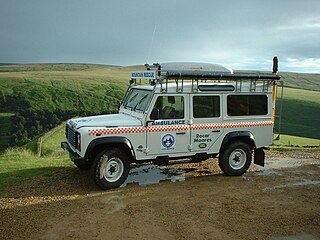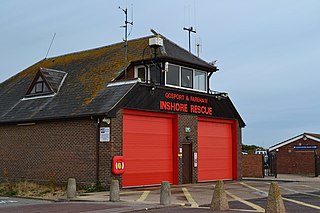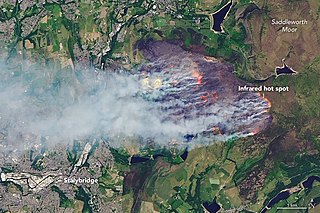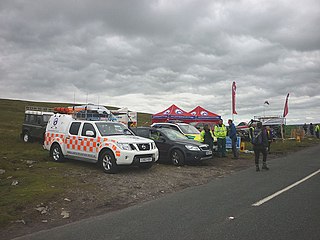
Bodmin Moor is a granite moorland in north-eastern Cornwall, England. It is 208 square kilometres (80 sq mi) in size, and dates from the Carboniferous period of geological history. It includes Brown Willy, the highest point in Cornwall, and Rough Tor, a slightly lower peak. Many of Cornwall's rivers have their sources here. It has been inhabited since at least the Neolithic era, when primitive farmers started clearing trees and farming the land. They left their megalithic monuments, hut circles and cairns, and the Bronze Age culture that followed left further cairns, and more stone circles and stone rows. By medieval and modern times, nearly all the forest was gone and livestock rearing predominated.

The River Fowey is a river in Cornwall, England, United Kingdom.

The National Coastwatch Institution is a voluntary organisation and registered charity providing a visual watch along the UK's coasts, and is not to be confused with HM Coastguard.

Severn Area Rescue Association (SARA) or Severn Rescue is an independent, marine and land based, search and rescue organisation covering the Severn Estuary and upper reaches of the River Severn. SARA is the largest independent lifeboat service in the UK, second only to the RNLI, with 22 operational inshore lifeboats, 20 vehicles and approximately 200 personnel. They receive no funding from the RNLI.

Mountain rescue services in England and Wales operate under the association of Mountain Rescue England and Wales (MREW), formerly called Mountain Rescue Council of England & Wales. The association has a number of regional mountain rescue teams, each of which is an independent charity. The team members are highly trained volunteers who are called out by the police.

The Holme Valley Mountain Rescue Team is a voluntary organisation that functions as a search and rescue service covering the southern half of West Yorkshire. It is a registered charity entirely funded by public contributions.

Cornwall Fire and Rescue Service is the statutory fire and rescue service covering Cornwall, England. As of April 2019, the service employs over 400 retained firefighters, 203 full-time firefighters, plus 170 support and administrative staff. Created under the Fire Services Act 1947 as "Cornwall Fire Brigade", the name changed to "Cornwall Fire and Rescue Service" on 1 October 2009.
The Cave Rescue Organisation (CRO) is a voluntary body based in the caving area of the Yorkshire Dales in northern England. Founded in 1935, it is the first cave rescue agency in the world.

The Scarborough and Ryedale Mountain Rescue Team provides Search and Rescue services in and around the Scarborough and Ryedale areas of North Yorkshire, England. The team has no formal southern boundary and has carried out searches in the urban fringe areas of the East Riding of Yorkshire

Gosport Lifeboat Station is a volunteer-operated independent lifeboat station charity located in the village of Alverstoke on the peninsula of Gosport in the English county of Hampshire. Owned and operated by Gosport and Fareham Inshore Rescue Service (GAFIRS), it operates free lifeboat services in the Solent from Portsmouth Harbour to Titchfield Haven, on the approaching shores of Southampton Water. GAFIRS is a charity registered in England and Wales (1159681).

Surrey Search and Rescue (SurSAR) is a lowland search and rescue team based in Surrey, United Kingdom, who respond for missing person search, water rescue, drone imaging and other taskings at the request of Surrey Police and Surrey Fire and Rescue Service, as well as other statutory and government agencies. In common with most UKSAR teams, SurSAR's members are volunteers. The team has been a registered charity in England and Wales since October 2011.
The Upper Wharfedale Fell Rescue Association is based in Grassington in the Yorkshire Dales of northern England, and provides help to people and animals in difficulty in the caves and on the fells around Wharfedale, Nidderdale, Littondale and Mid-Airedale. Although it is staffed by approximately 80 volunteers and funded by donations, it is integrated into the emergency services and is called out by the police when there is an appropriate incident. The Upper Wharfedale Fell Rescue Association was founded in 1948, and is the third oldest such team in the UK.

The Isle of Man Civil Defence Corps is one of the five emergency services maintained by the Isle of Man Government, to provide a range of emergency responses on the Isle of Man, an independent Crown dependency located in the Irish Sea between England and Ireland. The Corps operates under the Department of Home Affairs.

Starting on 24 June 2018 and continuing throughout the summer, a record-breaking series of wildfires burned across the United Kingdom. The two largest fires, which were declared major incidents, burned over 7 square miles each and broke out on Saddleworth Moor in Greater Manchester and Winter Hill in Lancashire. Other large fires broke out in Glenshane Pass in County Londonderry, Northern Ireland, Epping Forest, in London and in the Vale of Rheidol in Ceredigion, Wales. The Saddleworth Moor fire has been described as the largest English wildfire in living memory. Most of the wildfires occurred during the first official heatwave in the United Kingdom since June 2017, with temperatures reaching above 30 °C (86 °F) for several days, making the hottest June in the country since 1995, and the driest June for over ten years in large parts of the United Kingdom, exacerbating the crisis. A wildfire started on the Staffordshire Moorlands on 9 August and, despite rain, had spread to cover 219 acres by 11 August. Some hot spots were still burning as at 22 August. In total, there were 79 fires over the course of the year, a new record. However, the record was beaten in 2019 with 96 fires as of April 23.

The Swaledale Mountain Rescue Team (SMRT), is a voluntary organisation that undertakes search and rescue primarily in the Swaledale and Wensleydale area of the Pennines in North Yorkshire, England. Like other mountain rescue teams, SMRT does not confine itself to the immediate area and will respond to calls by emergency services and the public alike across a broad expanse of Northern England.
Cleveland Mountain Rescue Team is one of five search and rescue teams based in the North East region of England. The team is based in the village of Great Ayton in North Yorkshire. They were called out to 61 incidents in 2019, and 58 in 2020.

The Peak District Mountain Rescue Organisation (PDMRO) is a UK registered charity which was formed in 1964. The purpose of PDMRO is "to save life and alleviate distress, primarily in Upland and Mountain areas". This is achieved by conducting search and rescue missions for walkers, climbers and missing persons in and around the Peak District National Park.

The Buxton Mountain Rescue Team is a UK registered charity operating search and rescue missions from its base at Dove Holes near Buxton in Derbyshire. The team covers an area of about 400 square miles across Derbyshire, Staffordshire and Cheshire.

Mountain rescue in Wales refers to search and rescue activities that occur in the mountainous and other wilderness environments in Wales. Wales is largely mountainous with its higher peaks in the north and central areas, including Snowdon, its highest summit. Mountain rescue teams are called out through the police, via the 999 system, to assist police, fire and ambulance. They also work closely with the Air Ambulance and HM Coastguard helicopters as well as the search and rescue dog associations and cave rescue.















